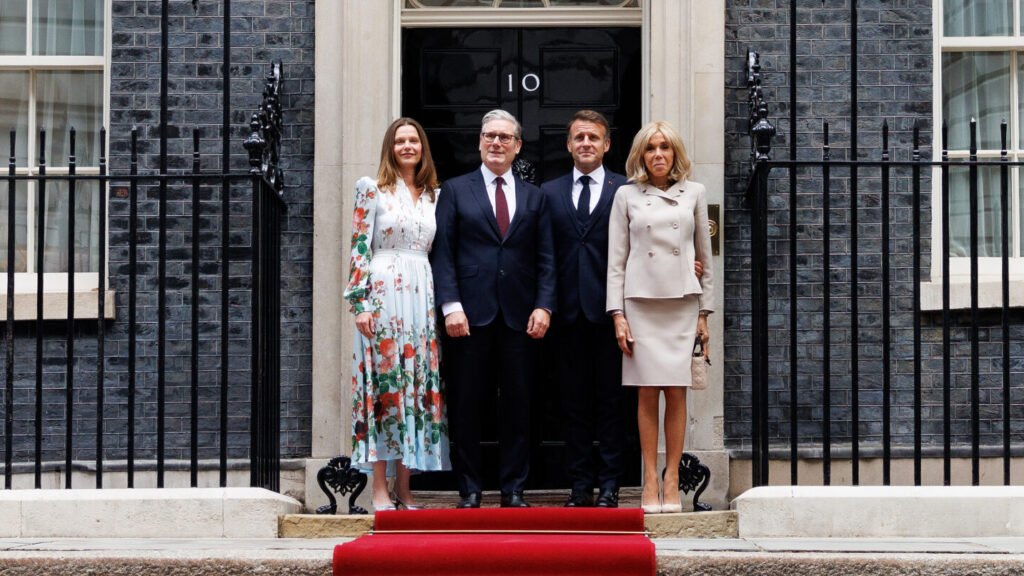 Prime minister Keir Starmer and his wife Victoria Starmer meet French president Emmanuel Macron and his wife Brigitte Macron at 10 Downing Street on 9 July Picture by Lauren Hurley / No 10 Downing Street
Prime minister Keir Starmer and his wife Victoria Starmer meet French president Emmanuel Macron and his wife Brigitte Macron at 10 Downing Street on 9 July Picture by Lauren Hurley / No 10 Downing Street
Details have emerged of the behind-the-scenes negotiations to bring the Bayeux Tapestry back to England for the first time in 900 years.
Announcing the deal an his address to UK Parliament during his state visit earlier this week, French president Emmanuel Macron joked that it “probably took more years to deliver this project than all the Brexit talks”.
The agreement, which will see France loan the tapestry in exchange for Sutton Hoo artefacts and other treasures from all four UK nations, was officially signed at the British Museum on 9 July, with Macron, UK prime minister Keir Starmer and the museum’s director Nicholas Cullinan in attendance.
In his address at the museum, Macron said King Charles III had played an instrumental role in the negotiations and admitted that French authorities had resisted the proposed loan for many years.
A previous signed agreement in 2018 fell through after tests found that the tapestry was in worse-than-expected condition and too fragile to travel.
Macron said: “I have to confess, we did our best not to be put in this situation to make the loan of the Bayeux tapestry.
“And we found the best experts of the world to explain in perfect detail why it was impossible to make such a loan. And believe me, we found them, and believe me, we could have found them again.
“But we just decided a few years ago, and I have to pay tribute to your king because it was a discussion together and I saw his attachment, his willingness, towards this project.”
In his speech at the event, Starmer praised the cultural exchange as a “brilliant initiative”.
He said: “Everybody is walking around here with a smile on their face and when the president yesterday announced to both houses what was going to be happening here there was a great cheer went up and that was representative I think of how this is being felt across the entire country.”
Starmer said the Bayeux Tapestry and Sutton Hoo artefacts were “two of the great treasures of [the] history” of the two nations.
“Both these treasures contain stories of war and of peace, of power and of politics, alliances and enemies that we still know all too well in our modern world,” he said. “They show us how connected our countries have always been, they deepen our appreciation of our shared history and enrich the relationship between our two nations today.”
The Bayeux Museum said it had delayed the earlier loan in order to discover more about the condition of the artefact. It agreed to go ahead with the loan because the tapestry was due to be moved in any case as work gets underway on a redevelopment of the museum.
“Of course there’s no such thing as zero risk but we are having to move it anyway as we’re working on the new museum where it will eventually be displayed,” a spokesperson for the museum told The Guardian newspaper.
“Our scientists have worked out a way to cause the least possible stress. The fact is we will be moving it anyway and to take it to the British Museum just means we’re moving it further. It’s emotional for the people of Bayeux, but the tapestry was never going to be on display here during the museum work.”
British Museum chair George Osborne said the exhibition of the tapestry, which will run from autumn 2026 to mid-2027, would be “the blockbuster show of our generation”.
“I know it will capture the imagination of an entire nation,” he added.
Enjoy this article?
Most Museums Journal content is only available to members. Join the MA to get full access to the latest thinking and trends from across the sector, case studies and best practice advice.